Thank you to Tudor Life regular contributor, Rioghnach, for asking this question:
"Claire's most recent chat on the subject of smallpox during the Tudor era has piqued my curiosity.
Elizabeth's portraits always make her skin look flawless. Obviously, this was not the case, but I can understand why her painters used tact and diplomacy in their works. Does anyone actually know for certain, what Elizabeth actually looked like under the layers of white lead etc?"
Although there are many portraits of Elizabeth I painted in her lifetime, it is impossible to use them as evidence of what the queen really looked like, particularly towards the end of her reign, because portraits of a monarch at this time were not meant to be accurate representations, they were propaganda.
Elizabeth was twenty-five when she came to the throne in November 1558 and she ruled until March 1603, when she was sixty-nine, but let's have a look at some of the portraits painted late in her reign, when she covered her greying and thinning hair with wigs and used layers of ceruse to make her "mask of youth". You can click on the portraits to see them properly.
- Jesus College, Oxford, c.1590
- Hardwick Portrait 1590s
- Jesus College, Oxford, c.1590
- Armada Portrait c. 1588
- Ditchley Portrait c.1592
- Procession Portrait c.1600-1601
- Elizabeth I and the Cardinal and Theological Virtues c.1598
- Ermine Portrait c.1585
- Hilliard miniature c.1595-1600
- Hilliard miniature c.1587
- Rainbow Portrait 1600-1602
- Hilliard miniature c.1590
And here is an eye-witness description of the queen in 1598:
"Next came the Queen, in the Sixty-fifth year of her Age, as we were told, very Majestic; her Face oblong, fair, but wrinkled; her Eyes small, yet black and pleasant; her Nose a little hooked; her Lips narrow, and her Teeth black (a Defect the English seem subject to, from their too great Use of Sugar); she had in her Ears two Pearls, with very rich Drops; she wore false Hair, and that red; upon her Head she had a small Crown, reported to be of some of the Gold of the celebrated Lunebourg Table; Her Bosom was uncovered, as all the English Ladies have it, till they marry; and she had on a Necklace of exceeding fine Jewels; her Hands were small, her Fingers long and her Stature neither tall nor low; her Air was stately, her manner of speaking mild and obliging [...]"
These portraits just don't tally with that description, do they?
We do, however, have a more realistic portrait of Elizabeth I. This portrait is owned by the Elizabethan Gardens in North Carolina, USA. It has been authenticated and dates to the early to mid-1590s. It is thought to have come from the studio of Marcus Gheeraerts the Younger, the artist who painted the Ditchley Portrait that you can see in the gallery above and which dates to the same period - very different!
Although Elizabeth I is still in all her finery, and wearing a wig, her skin is lined with wrinkles. Jonathan Jones, in an article on this portrait, writes:
"In the new, unvarnished portrait of Elizabeth I, wrinkles-and-all, the artist has stepped over a fine line. All the accoutrements of her glamour are there, but the painter has gone just that bit nearer to the reality behind the myth than was required to give a portrait plausibility. The result is a cruel unmasking of power. Could this have been a deliberately subversive image, hidden away in the house of some rebellious lord? Here is the fairy queen, her spell broken."
It makes you wonder who commissioned it!
Hannah Betts, in her article on this portrait for The Telegraph, writes:
"A 1596 order to the Privy Council commanded public officers “to aid the queen’s Sergeant Painter in seeking out unseemly portraits which were to her 'great offence’ and therefore to be defaced and no more portraits to be produced except as approved by [the] Sergeant Painter”. For a woman whose youthful, virginal, thus potentially ever fecund body had been the chief metaphor of her reign, what could be more offensive than the suggestion that it – and her rule – might be approaching their demise?"
Elizabeth knew the importance of propaganda, the importance of her subjects seeing her as still capable of ruling and not at death's door.
Only Elizabeth I's most trusted ladies would have known what Elizabeth really looked like under her finery and the layers of thick make-up, but in September 1599 one courtier, a man who had been a favourite of the queen's for many years, saw the queen without her wig and make-up:
"His lordship lighted at the court gate about ten in the morning, and made all haste up to the presence and so to the privy-chamber, and did not stop till he came to the queen's bed-chamber, where he found her majesty newly up, and the hair about her face."
Historian Tracy Borman writes of this event:
"When the impetuous Earl of Essex famously burst into her chamber before Elizabeth was dressed or made up, he was so shocked by her haggard appearance that he secretly joked about her “crooked carcass” to his friends. Elizabeth found out and it was said that she cut off his head in revenge – although his rebellion against her [in February 1601] probably had something to do with it."
However, Devereux did not make this comment in 1599 or to his friends, he actually said it to Elizabeth's face in 1598, the time when she slapped him for his disrespectful behaviour and he drew his sword. Edward Hyde recorded that Devereux rebuked the queen, saying that "she was as crooked in her disposition as in her carcass". The comment was not made after Devereux had seen the queen before she was ready in 1599.
Elizabeth was in her sixties in the mid to late 1590s, a good age for a Tudor person, and I suspect the eye-witness account from 1598 is accurate. Her red hair had greyed and was hidden by a wig, her face had wrinkled and her teeth had rotted, but she was still "majestic" and the eyes she had inherited from her mother, Anne Boleyn, were "black and pleasant". She was still very much a queen.
Notes and Sources
- Paul Hentzer's Journey into England in 1598, quoted in Side Lights on English History: Extracts from Letters, Papers, and Diaries of the Past Three Centuries edited by Ernest F. Henderson, University Press of the Pacific, 2004.
- "Elizabeth I's portrait brings us face to face with the ravages of age", Jonathan Jones, The Guardian, Wednesday 13 February 2013 - https://www.theguardian.com/artanddesign/jonathanjonesblog/2013/feb/13/elizabeth-first-portrait-face-age-unhappiness
- "7 things you (probably) didn’t know about Elizabeth I", Tracy Borman, History Extra, 2015, http://www.historyextra.com/article/facts-elizabethi
- Elizabethan Gardens portrait, Photographed by Ray Matthews, Courtesy of The Elizabethan Gardens.
- Edward Hyde is quoted in Hammer, Paul E. J.. “Devereux, Robert, second earl of Essex (1565–1601).” Paul E. J. Hammer In Oxford Dictionary of National Biography, edited by H. C. G. Matthew and Brian Harrison. Oxford: OUP, 2004. Online ed., edited by David Cannadine, October 2008. Hammer cites E. Hyde, ‘The difference and disparity between the estate and the conditions of George duke of Buckingham and Robert earl of Essex’, Reliquiae Wottonianae, or, A collection of lives, letters [and] poems, 4th edn (1685), p. 192.

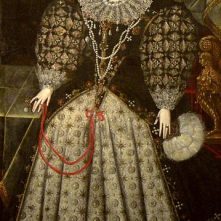
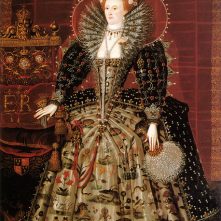
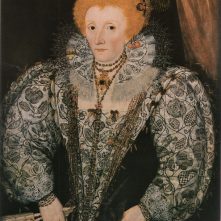
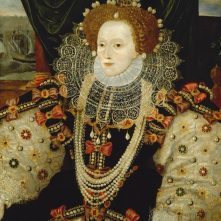
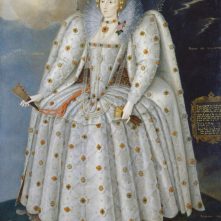
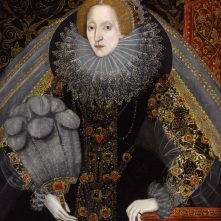
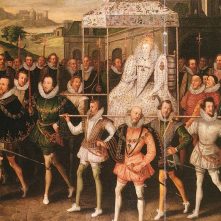
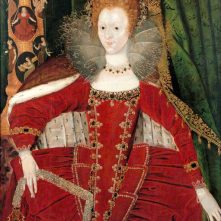
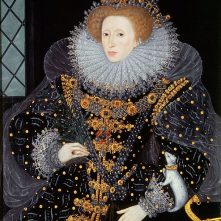
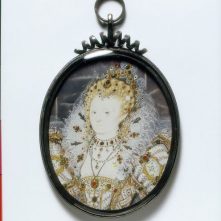
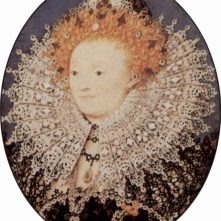
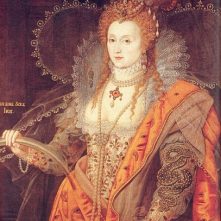
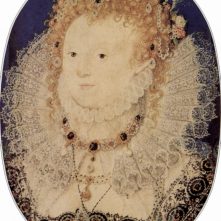
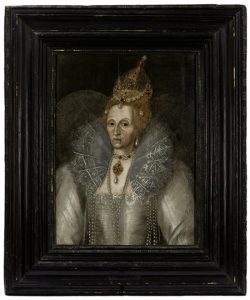
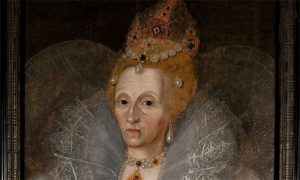
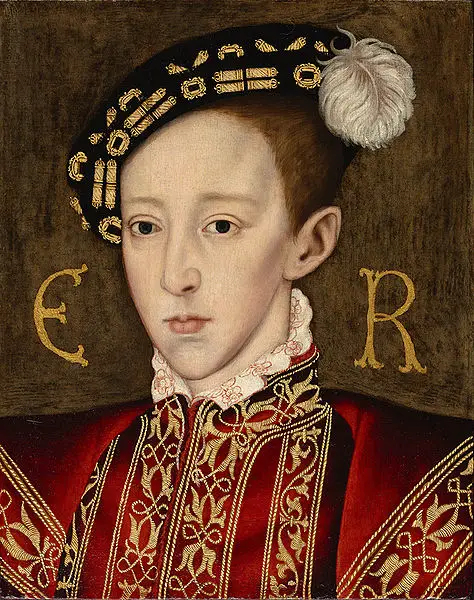
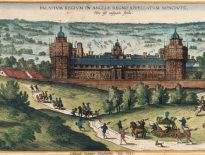
Interesting article, but what about the young Elizabeth? Clearly she was unmarked until the smallpox in 1560s and then only thirty. She was an attractive young woman with dark eyes and red hair, strongly resembling both parents. Anne Boleyn was no beauty and I doubt Elizabeth was a striking beauty but attractive. Mary, despite some later portraits was a very attractive young woman until ill health took its toll. Henry was also attractive until weight and a rapid rise in his weight and decline in health took its toll after the age of 45. Elizabeth, inspite of pox marks, was probably reasonable to look at until her 40s as well. Her face was covered in a white paste, partly as a fashion mystery and partly to hide these marks. However, as she grew older even with propaganda Elizabeth could not hide everything. She was in her 60s at this time so of course she had wrinkles. Her hair was thin and she wore various red wigs. Like her father she took time to dress and never appeared anywhere unless she was richly attired and as Queen her dresses became ever more elaborate. She had dressed more soberly as a Princess and it was Mary who was known for her rich apparel. Mary also used clothing well as Queen. It was an art and it was expected to show off wealth. This took time to put on and became a show in the seventeenth century. Her portrait does show what cannot be hidden, not even with make up, but even this is a powerful political weapon, one that shows age as wisdom and strength. Elizabeth is still Queen.
I focused on the older Elizabeth because it is later in her reign that she started using the thick make-up that we all hear about, but, yes, I could write another about the younger Elizabeth. I think the portrait of the young Elizabeth is probably accurate to how she looked as a teenager, and then there is the family portrait showing her and Mary with their father and the late Jane Seymour, plus the fools. You can see from that the resemblance between her and Mary then.
The white makeup cannot hide Elizabeth from the signs of age in her last portrait above. She actually looks quite frail and her face has shallow indentation. She made every effort to look like a Queen and the dress is magnificent. Her early looks are very much like her family, Mary and Henry are definitely like her, especially with that red hair. Henry found Elizabeth uncomfortable at times because she looked like him and had Anne’s eyes, which looked back at him. I think Elizabeth made him feel both pride and guilt as she was very intelligent and he had executed her mother. Mary’s redhead and Elizabeth’s equally marked them out as Henry’s children, their portraits show the similarities.
It is difficult to tell how much of the middle of Elizabeth I reign like the Armada portrait actually do look closely like her as they worked to a template. Some of those from the 1585 to 1596 period above are clearly made to show a much younger woman. Today we would say they are photo shoped. The white makeup is so finely applied that everything is very smooth. Elizabeth looks younger than she actually was. And that is without Max Factor! Maybe its a recommendation for now or maybe it is just an illusion. Either way it is a mystery preserving the majestic image and power of the Queen. Copies of these portraits were sent to loyal courtiers and to places that people could see them, given out as gifts and sent to other monarchs and their ambassadors. A piece of clever propaganda or realistic images, we really can’t be certain, but it was how Elizabeth wished to be shown. These are images of power. I like the Rainbow portrait because it is so colourful, not because of its symbols. However, it is full of so many symbols, with the Rainbow, the pearls for purity and eyes and ears to show the Queen sees everything. It also looks as if the Queen has been turned back in time as her white paint makes her look perfect and much younger, but the portrait is from 1602, before her death s year later. In contrast we see Elizabeth wrinkles and all in this and finally get a real look at the elderly, long reigned woman and Queen.
Thanks for answering my question, Claire.
I hadn’t seen the portrait of Elizabeth by Marcus Gheeraerts the Younger before. To me, Elizabeth looks very worn down by all the responsibilities of being Queen, in addition to her age. Quite sad actually.
I find Sir Walter Raleigh comment of Elizabeth as being “a lady whom time had surprised” to be quite odd. I gather that Raleigh was doing what all courtiers did in flattering Elizabeth, but I can’t help but wonder if there weren’t some who found such comments to be rather patronizing.
It can not have been easy for Elizabeth to reign as a woman, and an unmarried woman at that. I am by no means saying that Elizabeth wasn’t up to the task, quite clearly she was her father’s daughter in that respect.
I’m also wondering if there were some differences in courtly etiquette between the Flemish and English courts that allowed Gheeraerts the Younger to be able to paint Elizabeth in a far more observational and true-to-life manner.
Was/is there a death mask impression of Elizabeth?